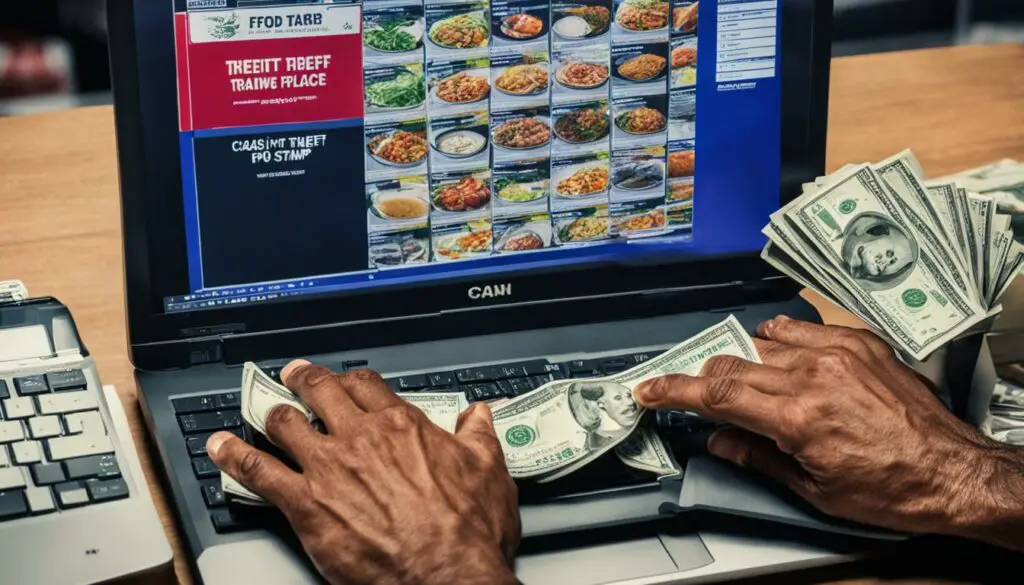Originally posted on December 25, 2023 @ 6:17 am
Food stamps, also known as the Supplemental Nutrition Assistance Program (SNAP), provide essential assistance to individuals and families in need. As a government program, many people wonder if their participation in SNAP has any impact on their credit. In this article, we will examine the relationship between food stamps and credit, debunking myths and revealing the facts.
Contrary to popular belief, participating in the SNAP program does not directly affect your credit score. Food stamp benefits are not reported to credit bureaus and do not have a direct influence on your creditworthiness or credit rating.
It’s important to understand that your credit score is based on factors such as payment history, credit utilization, length of credit history, and new credit applications. SNAP benefits do not factor into these calculations.
While food stamps themselves do not impact credit, it’s essential to be mindful of your overall financial well-being. Late payments and missed bills, regardless of whether you receive food stamps or not, can negatively affect your credit score. It’s crucial to manage your finances responsibly and make timely payments to maintain a healthy credit profile.
There are other financial implications associated with using food stamps that may indirectly affect your credit. For example, if you rely heavily on SNAP benefits and struggle to meet your other financial obligations, such as paying rent or utility bills, it could potentially impact your creditworthiness. However, this is a result of overall financial instability rather than direct consequences of using food stamps.
Table of Contents
Key Takeaways:
- Participating in the SNAP program does not directly impact your credit score.
- Snap benefits are not reported to credit bureaus and do not contribute to your creditworthiness.
- Your credit score is determined by other factors, such as payment history and credit utilization.
- Managing your finances responsibly is crucial for maintaining good credit, regardless of SNAP participation.
- Indirect financial implications, such as struggling to meet other financial obligations, could potentially impact your credit.
The Rise of Welfare Theft through Illicit Online Marketplaces

Criminals are capitalizing on the vulnerability of welfare recipients and engaging in welfare theft through the use of illicit online marketplaces. These marketplaces, found on social media platforms and the dark web, serve as a hub for the sale of stolen benefits information, leading to a rise in fraudulent activities.
The stolen benefits information, which includes sensitive personal data, is being used by criminals to clone debit cards. With these cloned cards, they illegally cash out stolen benefits, causing significant financial losses to both individuals and government programs.
Recent data breaches have further exacerbated the issue of welfare theft. Cybercriminals take advantage of these breaches to obtain large amounts of stolen EBT funds, fueling the illicit online marketplaces. The exact scale of welfare theft and its connection to specific breaches are still under investigation.
To combat welfare theft, it is crucial to strengthen security measures, enhance data protection protocols, and educate welfare recipients about the risks associated with sharing sensitive information online. Additionally, law enforcement agencies must be vigilant in identifying and dismantling illicit online marketplaces.
The Impact of Welfare Theft
“Welfare theft not only causes financial harm to individuals in need of assistance but also undermines the integrity of government programs designed to support vulnerable populations. It is essential to take effective measures to protect the welfare benefits of those who rely on them.”
Combatting welfare theft requires a multi-pronged approach involving collaboration between government agencies, financial institutions, and law enforcement authorities. By addressing the root causes and vulnerabilities that contribute to welfare theft, we can strive towards a more secure and just social welfare system.
| Type of Welfare Theft | Impact |
|---|---|
| Stolen Benefits Information | Enables criminals to clone debit cards and illegally cash out benefits |
| Data Breaches | Fuels the rise of welfare theft by providing cybercriminals with access to stolen EBT funds |
| Financial Losses | Significant financial impact on both individuals and government welfare programs |
| Undermined Trust | Erodes confidence in the integrity and effectiveness of welfare programs |
How Thieves Exploit Food Assistance Recipients
Thieves have discovered various ways to exploit vulnerable food assistance recipients and gain access to their electronic benefit cards. These cards are utilized in programs such as the Supplemental Nutrition Assistance Program (SNAP), as well as cash assistance and disability programs.
Once thieves obtain these electronic benefit cards, they often clone them to make fraudulent purchases or drain the accounts at ATMs, resulting in stolen funds from welfare recipients. These stolen funds can be used for various purposes, including resale for profit in underground marketplaces.
“Thieves clone electronic benefit cards of food assistance recipients to make fraudulent purchases or drain accounts at ATMs, resulting in stolen funds.”
While some states are taking steps to reimburse victims of stolen benefits, there are limitations on how often and how much benefits can be reissued. This means that victims may not fully recover the stolen funds or have their benefits restored to their original levels.
Safeguards and Awareness
It is crucial for food assistance recipients to be vigilant and take steps to safeguard their electronic benefit cards. This includes keeping the card safe and never sharing sensitive information, such as PIN numbers or account details, with anyone.
Additionally, it is essential for recipients to report any suspicious activity or unauthorized transactions on their electronic benefit cards to the appropriate authorities or program administrators. This helps in identifying and tracking down the culprits involved in the theft and preventing further losses.
The Impact on Vulnerable Individuals
The theft of food assistance benefits not only impacts the individuals who rely on these programs for their basic needs but also undermines the overall effectiveness of these assistance programs. The stolen funds could have provided crucial support to those in need and helped alleviate their financial hardships.
“The theft of food assistance benefits undermines the effectiveness of assistance programs and exacerbates the financial hardships faced by vulnerable individuals.”
In some cases, the stolen benefits may leave recipients without adequate resources to meet their basic needs, further pushing them into poverty and reliance on additional forms of assistance.
The Role of Encrypted Messaging Services in Welfare Theft

Cybercriminals are constantly finding new ways to exploit vulnerable individuals and steal valuable information. One tactic that has gained popularity is the use of encrypted messaging services. Platforms like Telegram provide the perfect environment for cybercriminals to exchange stolen information, including Electronic Benefit Transfer (EBT) details.
Encrypted messaging services offer a secure and anonymous channel for criminals to sell and purchase stolen EBT information. The use of end-to-end encryption makes it difficult for law enforcement agencies to trace these illegal activities. This has created a thriving marketplace where stolen EBT information can be bought and sold with ease.
Not only do cybercriminals sell stolen EBT information, but they also offer step-by-step guides on how to steal benefits. These guides, like the infamous “EBT Method,” provide detailed instructions on using popular services such as Instacart to exploit electronic benefits. The availability of such tutorials further fuels the growth of welfare theft.
Telegram: The Preferred Platform for Criminals
Telegram has emerged as one of the most popular encrypted messaging services among cybercriminals. Its user-friendly interface and robust security features make it an attractive choice for conducting illegal activities. The platform allows for the creation of private groups and channels, providing a hidden space for criminals to share and sell stolen EBT information.
Telegram’s encrypted messaging services have become the go-to platform for cybercriminals involved in welfare theft. Its secure and anonymous nature makes it difficult to track their activities, allowing them to operate with impunity.
In addition to facilitating illegal transactions, Telegram also provides a platform for criminals to network and share knowledge. Cybercriminals can exchange tips, discuss new techniques, and support one another in their illicit endeavors. This sense of community and shared expertise contributes to the sophistication of welfare theft operations.
The Impact on Welfare Recipients
The use of encrypted messaging services in welfare theft has severe consequences for vulnerable individuals who rely on these benefits. Stolen EBT information can lead to the unauthorized use of funds, leaving recipients without essential resources for food, housing, and other basic needs.
The proliferation of stolen EBT information on platforms like Telegram poses a significant challenge for law enforcement and benefits administrators. They must work tirelessly to identify and shut down illegal marketplaces while implementing stronger measures to protect welfare recipients from falling victim to cybercriminals.
It is crucial that individuals using public assistance programs remain vigilant in safeguarding their personal information and report any suspicious activity immediately. By staying informed and taking necessary precautions, welfare recipients can reduce the risk of becoming targets in this illicit online economy.
Skimming, Phishing, and Data Breaches in Benefits Theft

Skimming, phishing, and data breaches are common methods used in benefits theft. These tactics exploit vulnerabilities in benefit card systems and target unsuspecting recipients, leading to unauthorized access and the potential for financial loss. Understanding these methods is crucial in preventing and detecting benefits theft.
Skimming
Skimming involves the theft of information from benefit cards through devices installed on payment terminals or ATMs. These devices capture card details, including the cardholder’s name, account number, and PIN. Cybercriminals can then use this stolen information to clone benefit cards or make fraudulent transactions.
Phishing
Phishing is the fraudulent practice of tricking individuals into revealing sensitive information such as account numbers, passwords, or Social Security numbers. In the context of benefits theft, criminals may use unsolicited calls, texts, or emails posing as official government agencies or benefit providers to obtain recipients’ personal information. This stolen data can be used to gain unauthorized access to benefit accounts or commit identity theft.
“Please be cautious of unsolicited calls or emails asking for your personal information. Legitimate government agencies or benefit providers will not request sensitive information over the phone or through unsecured channels.”
Data Breaches
Data breaches pose a significant risk to benefit recipients’ personal information. When cyberattacks target databases or systems containing sensitive data, such as benefit card information, criminals can obtain vast amounts of stolen data. This stolen data can then be used in benefits theft, with criminals exploiting the information to make fraudulent transactions or clone benefit cards.
Data breaches provide cybercriminals with a large inventory of stolen data that can be traded, sold, or leveraged for illegal activities. These breaches may involve hacking into government systems, infiltrating third-party service providers, or exploiting vulnerabilities in security protocols. The stolen data becomes a valuable commodity in the underground market, contributing to the overall increase in benefits theft.
The Impact of Skimming, Phishing, and Data Breaches
While the exact extent of the impact of skimming, phishing, and data breaches on benefits theft is difficult to quantify, experts believe that these methods play a significant role in fueling the surge in such criminal activities. The combination of stolen card details, compromised personal information, and the availability of a flourishing illegal marketplace amplifies the risks faced by benefit recipients.
Protecting against benefits theft requires a multi-faceted approach, including robust security measures, public awareness campaigns, and proactive detection and response strategies. By understanding the tactics employed by cybercriminals, individuals and benefit providers can take steps to mitigate the risks and safeguard the valuable resources intended to support those in need.
Potential Connection Between Data Breaches and Benefits Theft

The Maze ransomware group has emerged as a potential player in the world of benefits theft, particularly through its alleged involvement in the breach of Conduent, an IT firm that handles the processing of electronic benefits. During this breach, personally identifiable information (PII) belonging to welfare recipients was exposed, providing cybercriminals with a valuable resource for orchestrating benefits theft on a larger scale.
It is believed that the stolen data obtained from the Conduent breach is being utilized by an organized crime syndicate to carry out benefits theft across multiple states. This suggests the existence of an interconnected network that leverages the stolen information to exploit vulnerable individuals and profit from their stolen benefits.
“The involvement of the Maze ransomware group and the organized crime syndicate highlights the alarming sophistication and coordination behind benefits theft operations.” – Cybersecurity Expert
By gaining access to benefits information, cybercriminals can clone electronic benefit cards and utilize them illicitly, resulting in financial losses for welfare recipients. The stolen data from the breach may also be sold on illicit online marketplaces, exacerbating the problems associated with benefits theft.
Recent Data Breaches and Benefits Theft Connections
| Data Breach | Organized Crime Involvement | Estimated Impact on Benefits Theft |
|---|---|---|
| Conduent | Maze ransomware group | Extensive, potentially nationwide |
| Other undisclosed breaches | Potential involvement | Under investigation |
The table above provides a snapshot of the current understanding of the connection between data breaches and benefits theft. However, as investigations continue and more breaches come to light, it is expected that further insights will emerge into the scale and extent of benefits theft driven by these breaches.
As law enforcement and cybersecurity agencies work to address this issue, it is crucial to implement stronger security measures to safeguard the personal information of welfare recipients. Furthermore, collaboration between government agencies, businesses, and individuals is necessary to detect and mitigate the impact of benefits theft and protect those who rely on these vital assistance programs.
Snap Usage and Nutritional Choices

Snap recipients have the freedom to choose how they utilize their benefits, including the types of food they purchase. However, studies have shown that a significant portion of SNAP benefits is spent on junk food, with soft drinks being a top choice among recipients.
Compared to non-SNAP households, SNAP recipients tend to allocate less of their benefits towards purchasing fruits and vegetables. This may be attributed to various factors, such as limited grocery budgets and the higher cost of fresh produce.
While SNAP is intended to provide access to nutritious food, the food choices made by recipients often lean towards less healthy options. This can be attributed to personal preferences, limited resources, lack of nutritional education, and the easy availability of processed foods.
It’s worth noting that SNAP recipients are not restricted in their food choices but rather encouraged to make informed decisions about their nutritional needs.
The Impact of Limited Budgets
One of the reasons SNAP recipients may opt for junk food purchases is the relatively lower cost of such items compared to healthier alternatives. Processed foods, including sugary snacks and beverages, are often more affordable and provide a higher caloric intake per dollar.
“When you only have a limited budget, you try to get the most for your money,” says Dr. Katherine Alaimo, an associate professor of food, science, and policy at Michigan State University. “You may be able to get more calories from a highly processed food, but it’s not going to be the nutritional quality of fruits or vegetables.”
The Balanced Approach
While it is essential to address the nutritional aspect of SNAP usage, it is equally important to consider the complex factors influencing food choices and access to affordable, nutritious options.
Educational programs and initiatives that promote nutrition education and provide practical guidance on healthier food choices can empower SNAP recipients to make more informed decisions. These programs should focus not only on the benefits of consuming fruits and vegetables but also on how to prepare them in cost-effective and delicious ways.
Creating Greater Access
Improving access to affordable, fresh produce is crucial in encouraging SNAP recipients to incorporate healthier options into their diets. This can be achieved through collaborations between public health agencies, local farmers’ markets, and community organizations to offer discounted prices, accept SNAP benefits, and provide nutrition education.
“If you have healthy foods in the community, they are more likely to be purchased,” says Alaimo. “But if you don’t have the availability and accessibility, people can’t purchase them, regardless of their intent.”
The Role of Policy
Policy changes can also play a significant role in promoting healthier food choices among SNAP recipients. Implementing restrictions or incentives that encourage the purchase of fruits, vegetables, and other nutritious foods while discouraging the purchase of unhealthy items can help shape consumption patterns.
“With the right policies in place, we can help ensure that more families receive the nutritional support they need, while also incentivizing healthier choices,” says Lisa Davis, Senior Vice President of No Kid Hungry, an anti-hunger organization.
By addressing the affordability, accessibility, and education around healthy food choices, we can strive to create positive changes in SNAP usage that benefit the long-term health and well-being of recipients.
Fraud and Resale of SNAP Benefits
SNAP (Supplemental Nutrition Assistance Program) fraud is a pressing issue with potential consequences for both recipients and taxpayers. While the detected fraud rate is estimated to be around 1%, it is believed that the actual fraud rate may be higher, as not all instances of fraud are detected. This means that there may be a significant amount of unreported fraud occurring within the SNAP program.
One form of SNAP fraud involves the resale of benefits. Some recipients choose to sell their SNAP cards or use their benefits to purchase groceries that they then sell to others at a discounted rate. This kind of resale indicates that the value of the benefits may be higher to taxpayers than to the intended recipients.
“SNAP fraud rates are estimated to be around 1%, but this only accounts for detected fraud.”
This issue of fraud and resale adds to the overall challenges faced by the SNAP program. It not only undermines the integrity and effectiveness of the program but also raises concerns about the misuse of taxpayer dollars.
Detected Fraud vs. Unreported Fraud
The detected fraud rate of 1% suggests that a significant amount of fraud is successfully identified and prevented. However, the actual fraud rate may be higher due to undetected cases. This highlights the need for improved detection methods and stricter enforcement to combat fraud and protect the integrity of the SNAP program.
Potential Consequences of SNAP Fraud and Resale
| Consequences | Description |
|---|---|
| Financial Loss | Fraud and resale divert funds intended for vulnerable individuals, resulting in a financial loss for the program and potentially limiting support for those in need. |
| Reduced Trust | Instances of fraud and resale erode public trust in the SNAP program, leading to skepticism about the program’s effectiveness and the proper use of taxpayer dollars. |
| Wrongful Denial of Benefits | Fraud and resale may lead to eligibility issues or benefits being wrongfully denied to those who genuinely need assistance. |
| Stigmatization of Recipients | Fraud cases can contribute to the stigmatization of SNAP recipients, further perpetuating misconceptions and biases surrounding the program. |
Fighting SNAP fraud requires a multi-faceted approach that combines proactive prevention measures, stringent enforcement, and ongoing education for both recipients and program administrators. By addressing the issue of fraud and resale, the SNAP program can better fulfill its mission of providing crucial nutritional assistance to those in need.
Conclusion
Food stamps and credit are two separate entities that do not have a direct impact on each other. While there have been cases of welfare theft, it does not significantly affect one’s credit score. However, the rise in welfare theft highlights the importance of implementing stronger security measures to safeguard vulnerable individuals from cybercriminals.
It is crucial to recognize that the Supplemental Nutrition Assistance Program (SNAP) has certain limitations. While it provides assistance for low-income individuals and families to purchase food, it may not effectively promote healthy food choices or address the underlying causes of poverty. There is a need to evaluate and enhance the program to better serve those in need.
In conclusion, while food stamps may not impact credit directly, the consequences of welfare theft and the limitations of SNAP call for continuous efforts to improve the system. By focusing on the security of benefits programs and addressing the root causes of poverty, we can ensure that these vital resources effectively support individuals and families in their journey towards financial stability and well-being.
FAQ
Do food stamps affect your credit?
No, food stamps do not directly impact your credit score. Your creditworthiness is determined by factors such as payment history, debt levels, and length of credit history. However, the rise in welfare theft highlights the need for increased security measures to protect vulnerable individuals.
How does welfare theft occur through illicit online marketplaces?
Cybercriminals purchase stolen benefits information on illicit online marketplaces, clone debit cards, and cash out. Recent data breaches have fueled these marketplaces, potentially putting the security of food stamp benefits at risk.
How do thieves exploit food assistance recipients?
Thieves target food assistance recipients to gain access to electronic benefit cards used for programs like SNAP, as well as cash assistance and disability programs. They clone these cards and use them to make fraudulent purchases or drain the accounts at ATMs.
What role do encrypted messaging services play in welfare theft?
Cybercriminals have turned to encrypted messaging services like Telegram to sell stolen EBT information. These platforms provide accessible and easy-to-use channels for exchanging illegal information. Criminals also sell step-by-step guides on how to steal benefits, such as the “EBT Method,” which explains how to use Instacart to steal electronic benefits.
What are common methods used in benefits theft?
Skimming, phishing, and data breaches are common methods used in benefits theft. Skimming involves stealing information from benefit cards, while phishing uses unsolicited calls, texts, or emails to trick recipients into revealing their information. Data breaches provide criminals with large amounts of stolen data that can be used for benefits theft.
Is there a potential connection between data breaches and benefits theft?
The Maze ransomware group is suspected of being involved in benefits theft through a breach of the Conduent IT firm, which handles the processing of electronic benefits. The breach exposed personally identifiable information for welfare recipients, and it is believed that this stolen information is being used in benefits theft across multiple states.
What are the nutritional choices of SNAP recipients?
SNAP recipients are found to spend a significant portion of their benefits on junk food, with soft drinks being a top purchase. On average, they spend less on fruits and vegetables compared to non-SNAP households. This may be due to smaller grocery budgets and the higher cost of fresh produce.
What is the fraud rate of SNAP benefits?
SNAP fraud rates are estimated to be around 1%, but this only accounts for detected fraud. It is believed that the actual fraud rate may be higher, as not all instances of fraud are detected. SNAP cards or groceries are often resold to others at a discounted rate, indicating that the benefits may be worth more to taxpayers than to recipients.
What are the consequences of welfare theft and SNAP limitations?
While food stamps do not directly impact your credit score, the rise in welfare theft highlights the need for increased security measures to protect vulnerable individuals. Additionally, SNAP has limitations in promoting healthy food choices and addressing the root causes of poverty. It is crucial to evaluate and improve the program to better serve those in need.
Source Links
- https://www.thebaltimorebanner.com/politics-power/national-politics/snap-benefits-stolen-telegram-XZWBQARNKFG4NHQAH6JUQRRGBU/
- https://fee.org/articles/snap-the-uncomfortable-truths-about-the-food-stamp-program/
- https://www.ssa.gov/policy/docs/ssb/v67n4/v67n4p71.html
See also:
Leave a Reply